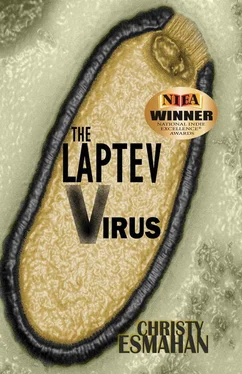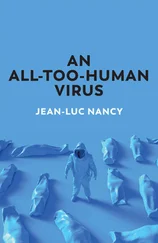“Yes, it’s a huge deal, Sarah, so humor me for six weeks or so. It could be less. They said they didn’t think it would need to be for a longer time period since Megaviridae are a really hot topic and laboratories all over the world are focused on the problem they are having up in the Arctic. It’s not in the media yet, but that doesn’t mean there aren’t a lot of eyes on it.”
“Do we know anything about the mode of transmission?”
Rhonda exhaled and reached for a folder on her desk which she slid over to Sarah. “At this time we’re not sure how it’s transmitted, though it will likely be through aerosols as the people in the field were pretty covered up.”
As Sarah flipped through the papers in the folder she ran her left hand through her ponytail. It was something she always did when she was worried or alarmed. Viruses that were transmitted on tiny droplets of moisture in the air, aerosols, were the most difficult ones to prevent from spreading. The common flu and avian flu viruses were also transmitted in this manner. Released from throats or nasal passages, in the form of sneezes and coughs, these viruses could travel quite far.
The highly contagious measles virus could linger in the air for up to two hours after leaving the throat of an infected person, waiting patiently to infect its next victim, as the parents of unvaccinated children who went to amusement parks could attest.
“Ebola and HIV viruses, as you well know,” said Rhonda, “are only spread through direct contact of infected bodily fluids with the blood of the recipient. Even tiny cuts on the skin or in the mouth could admit these deadly pathogens, and thus they spread all too rapidly in vulnerable populations. But this new pathogen seems to begin its infection in the lungs.”
Sarah watched Rhonda attentively as she spoke. Her short brown hair was styled attractively around her face, where it remained locked stiffly in place, like castle walls guarding the treasure inside. Heavy black eyeliner wound the circumference of her large dark eyes and her crimson lipstick, which matched her suit, was applied perfectly to her handsome lips, seeming to reflect ruby glints of light as she spoke.
“The Laptev virus has taken out quite a few people up there in one of the research barracks in the Arctic. We need to neutralize it as soon as possible. Finding a cure or a vaccine would be amazing, though I don’t expect your team to accomplish something like that in this short of a time frame. However, if we are able to make some decent progress in understanding the biology of Laptev, I can assure you that Riesigoil might be willing to provide resources for four or five years of AIDS research.”
Sarah tore her gaze from Rhonda and sought out the dark green leafy branches of the gnarled post oak trees that lined the sidewalks outside the window. Laptev. It was a word that would soon enter the average person’s lexicon, just as Ebola and HIV had. She drew in a deep breath and looked around the office. Off to the side were the plaques from Rhonda’s degrees and various awards that she had earned while working at the CDC. They were not ostentatious, but they did convey a sense of quiet strength.
“Okay, I understand. We’ll take on the Laptev virus project. I just wish it could have waited a few more months.”
Rhonda regarded her for a long moment. “I know, Sarah,” she said, a bit of compassion leaking into her softening voice. “But even if I wanted to, I couldn’t take back the directive to have your team working on the megavirus problem. You see, my hands are tied right now, since Oscar has said that this is a priority.”
Then Rhonda smiled conciliatorily and began speaking about the paperwork that would need to be signed. “I’ll e-mail you the contract. The company will maintain full ownership of all of the research findings, and you won’t be allowed to publish any of the results without full written permission from them.”
Sarah reached down to massage her leg, just above the boot, where it throbbed.
“I’ll need to inform my team this afternoon,” she said, and her tone must have betrayed the doubt and disappointment she felt.
“I know it isn’t easy to stop in the middle of a project, Sarah. But it is precisely because your team has experience with strange viruses that you are better suited for this line of investigation than any of the other investigators here at the IDI.”
On her way back down to the lab, Sarah thought about the steps that would need to be taken in order to stop their investigations in one area and begin them in another. She needed to have a team meeting and break the news to them. She knew they would be dismayed, but there was no way around it.
After an eternity, the elevator doors whispered open on the third floor and revealed the sign that always made her heart skip just a little bit. MEDICAL MICROBIOLOGY RESEARCH, Sarah Spallanzani, Ph.D. She exited and turned right, heading toward her office.
Sarah’s research group consisted of three full-time investigators, Tally, Emile and Drew, and two postdoctoral researchers, Miquela and Shane, as well as several technicians. When they weren’t being derailed by Rhonda, former CDC expert, they investigated the human immunodeficiency virus, or HIV, the virus responsible for causing AIDS.
It certainly was a strange virus, Rhonda had that much right. That’s why it had taken scientists by surprise when it debuted on the world stage in the late ’70s. Sarah pictured her undergraduate virology professor, a passionate man with curly white hair frosting his large head, and who had smoked a pipe during lectures. She remembered when he first introduced the subject of viruses.
“Viruses are relatively simple structures, made up of a strand of genetic information, usually DNA, covered in a protein coat called a capsid. That’s it.”
Laying his pipe gingerly on a table, he had taken a piece of chalk and drawn a squiggly line on the board to symbolize the DNA, and then a hexagon shape around that to represent the capsid. Then he had wiped his hands together to eliminate the chalk dust, and stepped away, leaving the class to ponder that thought for a few minutes.
Delighted by the simplicity of this definition, Sarah had decided right then and there that she would specialize in virology, not because she believed that viruses were simple structures, but because she was convinced that there was an awful lot behind that simplicity.
Most of Sarah’s friends in college were not majoring in science, let alone microbiology, and they tended to use generic terms like “germs”, or even worse, “bugs” to describe everything that could induce illness. She had been so exasperated that sometimes she would say in an impassioned voice, “They are not alike at all. Even the simplest bacterium is much larger and more complicated than a virus particle. Bacterial cells have organelles, a circular strand of DNA, cytoplasm, a cell membrane and often a complex cell wall. Furthermore, whereas bacteria and all living cells can be killed, viruses are merely deactivated.”
Her friends would roll their eyes and usher her off the soapbox. More disturbing were her first dates that withered when the conversation became intellectual. Discussing science, she had learned, was a great way to make a man lose interest. “Men are intimidated by smart women,” her roommate had confided. “If you want dates, you need to play dumb.”
But Sarah’s indomitable spirit refused to fold neatly into the perfect woman so many of her classmates purported to be. Thus she would return to her dorm after another sour date, gritting her teeth as the bell tower struck nine on a Saturday night.
Graduate school was more fulfilling. She had met her husband and had been briefly tempted to veer from virology by some intriguing cancer research, but had soon returned to her first passion. Now she was surrounded by people who loved to talk about the same things that she did, and she no longer had to apologize for her intelligence. She had endured a post-doctorate in Chicago under a world-renowned virologist, and when the position had opened up at the UT medical school in Houston, she had immediately applied for it.
Читать дальше












